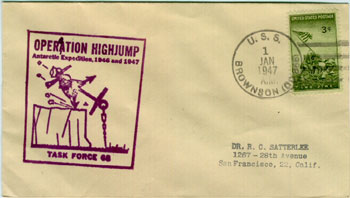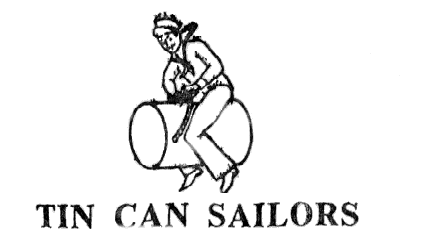|
USS
Brownson (DD-868)
The standard four-bar postmark was used by the Brownson during the expedition (figure 1). The only other reported is a three-line rubber stamp return
address found on a January 1, 1947 cover thusly: USS BROWNSON
(DD 868) / c/o Fleet Post Office / New York, New York (not shown), and
a LARGER version found on my illustrated cover above. (See figure 2).
Courtesy of the.. 
Keel laid February 13, 1945, at Bethlehem Steel Company, Staten Island, New York, as hull number 8063. Designed and engineered by Gibbs and Cox as a destroyer of the 692 class (long hull). The specifications were:
Admiral Brownson had a record of forty-two years continuous active service in the U.S. Navy, having been graduated from the U.S. Naval Academy in 1865, served as Superintendent of that institution from 1902 to 1905, as Commander in Chief, U.S. Asiatic Squadron from 1906 to 1907, as Chief of the Bureau of Navigation from 1907 until his resignation from active service. Ensign Caroline Brownson Hart (w) USNR, Granddaughter of Admiral Brownson, was sponsor for the ship. The USS BROWNSON is the second ship of the U.S. Navy to be named in honor of Admiral Brownson. The first, DD-518, was commissioned February 3, 1943, and was sunk by enemy action off the island of New Britain during the second Guadalcanal Campaign on December 26, 1943. According to the record, she was hit by three bombs. The USS BROWNSON was first commissioned a vessel in the United States Navy on November 17, 1945. Her first Commanding Officer was Commander William R. Cox, U.S. Navy, a graduate of the U.S. Naval Academy of the class of 1933. She underwent her shakedown cruise at Guantanamo Bay, Cuba, from January to March of 1946. She served as training ship for Destroyer Engineer Officers from April to June of 1946 at Portland, Maine. She was immobilized at Bath Iron Works, Bath, Maine, from June to October of 1946. Commander Harry M.S. Gimber, Jr. U.S. Navy, class of 1932, relieved Captain Cox of command of the USS BROWNSON on November 2, 1946. She reported for duty with Commander Task Force 68 on December 2, 1946, and shoved off for the Antarctic in company with USS MOUNT OLYMPUS and USS PINE ISLAND. First transited Panama Canal on December 7, 1946. First crossed equator on December 12, 1946. She was underway in the Antarctic from January to March of 1947. She crossed the Antarctic Circle 76 times during that period. Crossed Greenwich Meridian at the Antarctic Circle. Attempted to make a landing in the Antarctic on Charcot Island but the attempt was unsuccessful because of heavy field ice within three miles of the coastline. She rounded the Horn on February 22, 1947. Visited Rio de Janeiro in March 1947. Returned to continental United States in April 1947. She operated with Destroyers, U.S. Atlantic Fleet, as a unit of Destroyer Division 101 and Destroyer Squadron Ten, from May to August, 1947, at Newport, Rhode Island. Commander William T. Powell, Jr., U.S. Navy, class of 1935 relieved Captain Gimber of command of the USS BROWNSON on July 26, 1947. Entered Boston Naval Shipyard and drydock on September 11, 1947 for regular shipyard availability. Departed shipyard January 1948. Commander John N. Ferguson, Jr., U.S. Navy class of 1935, relieved Captain Powell of command of the USS BROWNSON on February 8, 1948. Participated in U.S. Atlantic Fleet Maneuvers February 1948. Reported to Commander, U.S. Naval Forces, Mediterranean on February 28, 1948. She joined the 6th Fleet in the Mediterranean. The various ports the USS BROWNSON visited on her first Mediterranean cruise were: Gibraltar, Bone & Sfax, North Africa; Argostoli, Salonica, and Athens, Greece; Trieste and Venice, Italy; Island of Malta; Island of Crete. She returned to Newport in June 1948 and spent until May 1949 conducting reserve cruises. In May 1949 she entered Boston Naval Shipyard for an extensive modernization which lasted until March 1950. She conducted refresher training in the Caribbean and in the summer of 1950 made a Midshipman cruise in the Caribbean. During night operations off Bermuda on November 8, 1950 the USS BROWNSON collided with USS CHARLES H. ROAN (DD-853). She went to drydock in Bermuda and then to Philadelphia for repairs and further modernization. Leaving the yard in February 1951, she joined the 6th Fleet in the Mediterranean. The period between October 1951 and August 1952 was spent in the vicinity of Newport. In August 1952 she went to the North Atlantic with the 2nd Fleet for NATO's OPERATION MAINBRACE. In October 1952 she rejoined the 6th Fleet in the Mediterranean. Returning to Newport in February 1953, she operated along the Atlantic seaboard and in the Caribbean until August 1954, with the exception of the one Midshipman cruise and participation in OPERATION SPRINGBOARD. The following are some of the ports the USS BROWNSON visited for the period of July 1950 to February 1954: Port au Prince, Haiti; St. Thomas, Virgin Islands; San Juan, Puerto Rico; Havana, Cuba; Weymouth, England; Plymouth, England; Greenock, Scotland; Bermuda; Reykjavik, Iceland; Lisbon, Portugal; Augusta Bay, Sicily; Latakia, Syria; San Reno, Taranto, Naples, Venice, La Spezia, and Pisa, Italy; Istanbul, Turkey; Athens, Greece; Beirut, Lebanon; Tripoli; Barcelona, Spain; Gibraltar; Cannes, Marseille, Villa, Gulf Juan, Nice, France; Monaco; Isle of Capri; Island of Crete. She departed Newport on August 2, 1954 for an extended tour in the Far East with the 7th Fleet. In the Far East, the USS BROWNSON cruised in Japanese, Philippine and Korean waters until January 1955. Departing the Far East, she returned to the East Coast, via the Suez Canal, arriving at Newport on March 14, 1955. The second of the USS BROWNSON'S round-the-world cruises came in 1956, when she passed through the Suez Canal only hours before the Anglo-French Action. But due to the blocking of the canal, the Brownson became trapped in the Red Sea, where she spent two months before continuing on around the world. In October 1958 the USS BROWNSON marked a new era in her career when she joined the newly formed Destroyer Development Group Two. This group developed tests and evaluated new equipment to strengthen the fighting power of the naval ships. Along with the USS BROWNSON, this group included the USS PURVIS (DD-709); USS GAINARD (DD-706); USS DICKSON (DD-708); USS GLOVER (AGDE-1); USS GLENNON (DD-840); USS WITEK (DD-848); and the USS WILKIINSON (DL-5). The USS BROWNSON'S major effort was concentrated on anti-submarine warfare. In accomplishing this mission she operated along the Atlantic Coast, from Newfoundland to Key West. Also, it should be noted that for two years in a row, the USS BROWNSON won the award for excellence in anti-submarine warfare in Destroyer Development Group Two. The USS BROWNSON was the first ship to augment its ASW capability with an operational type variable depth sonar, thereby combining her well-known surface agility with sub-like accuracy in detection. The VDS was later removed during FRAM overhaul. After an overhaul at the Boston Naval Yard in 1961 she went to the Caribbean for extensive refresher training at Guantanamo Bay and then participating in OPERATION LANT FLEX 4-61, a major amphibious exercise landing on the Island of Viegues. In October 1962, the USS BROWNSON joined other ships and helped quell the explosive Cuban Missile Crisis. In December, she returned home to Newport, R.I. to resume normal operations. In June 1963, the USS BROWNSON entered the Boston Naval Shipyard for her FRAM MKI conversion. The overhaul and renovation made her a new ship and as modern as any destroyer in the fleet. In April 1964, the USS BROWNSON again rejoined the Destroyer Development Group Two. After six weeks of refresher training at Guantanamo, she returned to Newport to prepare for a Mediterranean deployment with the 6th Fleet. The USS BROWNSON left for the Mediterranean in August 1964. Ports of call on this cruise were: Golfe Juan, France; Naples and Liverno, Italy; Athens and Rhodes, Greece; Barcelona, Spain; Cagliari, Sardinia; Pollonsa Bay, Majorca. The Brownson returned to Newport, R.I. in December 1964 and rejoined Destroyer Development Group Two. In February 1965, the USS BROWNSON was outfitted with DASH Helicopters to complete the FRAM MKI conversion. After a ten week Goodwill Tour to Northern Europe, the USS BROWNSON returned to Newport in September 1965. During this cruise she visited the following ports of call: Thurso, Scotland; Ballycastle and New Castle, Northern Ireland; Cowes and Penzance, England,; Le Havre, France; Bilbao, Spain; Amsterdam, the Netherlands; Karlskrona and Norrkiping, Sweden; Flensberg, Germany; Copenhagen, Denmark; and the Kiel Canal. In 1965 the USS BROWNSON was awarded the Battle Efficiency "E" Award and the Engineering Efficiency Award for Destroyer Development Group Two. In July 1966, the ship was assigned to the Destroyer School. This mission was to train junior officers for the billet of Department Head aboard the Fleet's Destroyers. September 1966 found the USS BROWNSON preparing for deployment to the Far East with Destroyer Squadron 20. From October 1966 until April 1967, she took part in a seven month cruise around the world. While on this trip, the USS BROWNSON proudly participated in the Combat Zone off the coast of Viet Nam while operating with the 7th Fleet. She provided naval gunfire support for allied ground operations, and also provided plane guard escort duty for carrier operation in the Gulf of Tonkin. The ship spent the first 20 days of February 1967 on the "Gunline" off the coast of South Viet Nam. She fired over 3200 rounds of ammunition in support of allied troops and the harassment of the enemy, in the area around the mouth of the Saigon River. Ports of call on this cruise were: Pearl Harbor, Hawaii; Kaohsiung, Taiwan; Hong Kong; Subic Bay, Philippines; Singapore; Cochin, India; and Aden, in the Red Sea. She continued to operate along the East Coast and deploying to the Mediterranean with the 6th Fleet. Returning to Boston in 1967 for overhaul. Departing in June of 1968 for Guantanamo Bay, Cuba ending the year out in Newport, R.I. She operated there throughout 1969-71 and deployed to the Mediterranean June 1972, stopping in Rota, Sicily, Naples, Khios, Greece and Turkey. Returning to Newport holding operations in the first part of 1973, and shifting her home port to Mayport, Florida August 1973. Departing Mayport January 4, 1974 for Rota, Spain, then for Rotterdam, Holland January 24th, returning to Plymouth, England February 14, departed for the Mediterranean. Returning to Mayport June 3, 1974. On April 15, 1975 the USS BROWNSON hauled in the lines and was underway for a six month deployment with Commander, Middle East Forces. After a four day visit in Dakar, Brownson transited to Accra, Ghana where she played host to the newly appointed United States Ambassador to Ghana, Shirley Temple Black. On May 9, the day after departing Accra, Ghana, USS BROWNSON crossed the equator on the Greenwich Meridian. One sixth of the ship's company, the Shellbacks, subjected the remainder of the crew to the historic initiation into King Neptune's ancient order. She made a brief stay for fuel in Mocamedes, Angola, then journeyed around the Cape of Good Hope to Mombasa, Kenya with a British destroyer and oiler enroute. The USS BROWNSON returned to Mayport, Florida and was decommissioned and struck from the Navy Register September 1976. All of us shipmates should be proud of the USS BROWNSON'S record of active service for more than 30 years.
|




